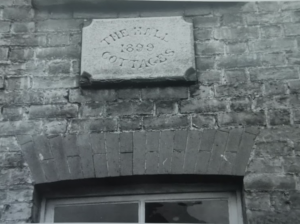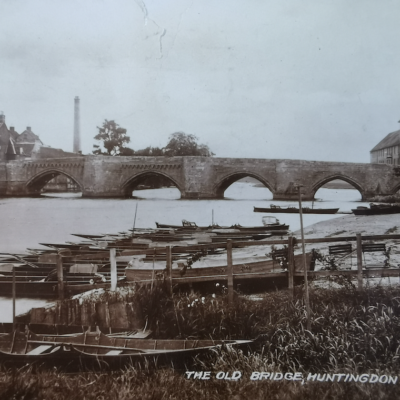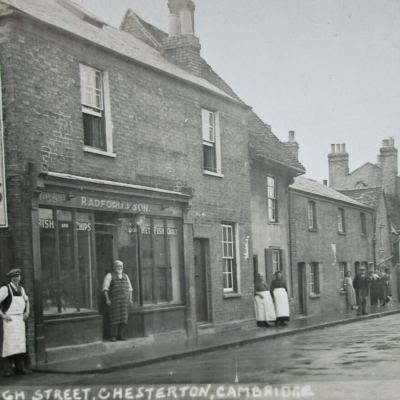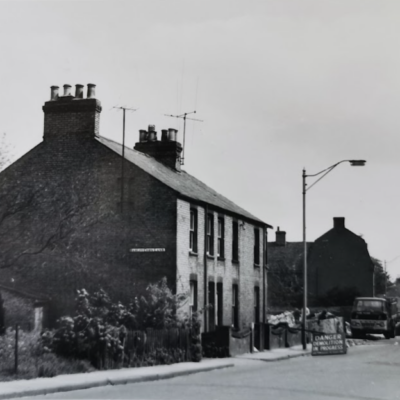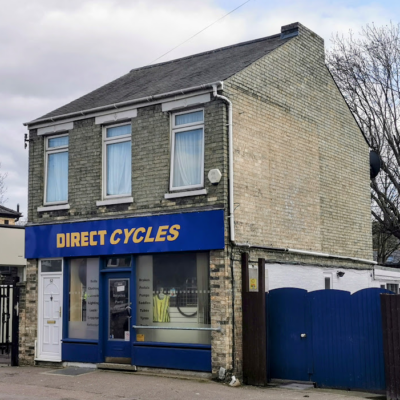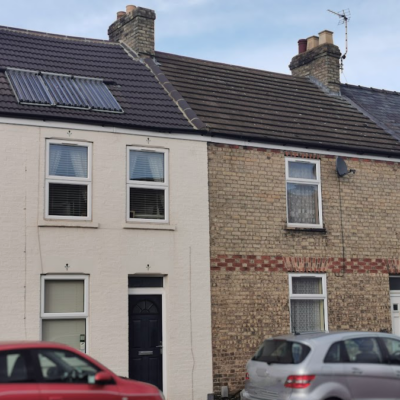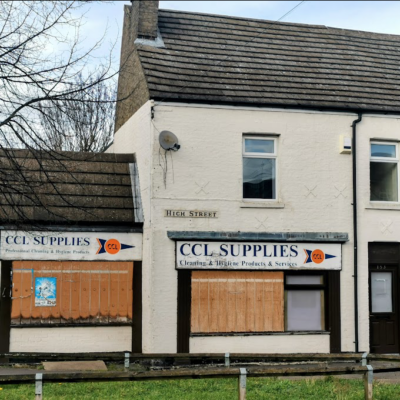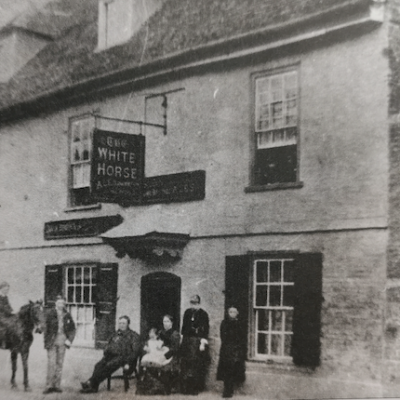Search by topic
- archaeology
- Building of Local Interest
- charity
- church
- crime
- dressmaker
- fire
- Great Eastern Railway
- Listed building
- Mapping Relief
- medieval
- oral history
- poverty
- Public House
- Rattee & Kett
- Religious House
- Roman
- scholar
- school
- Then and Now
- tudor
- women
- work
- world war one
- world war two
Search by text
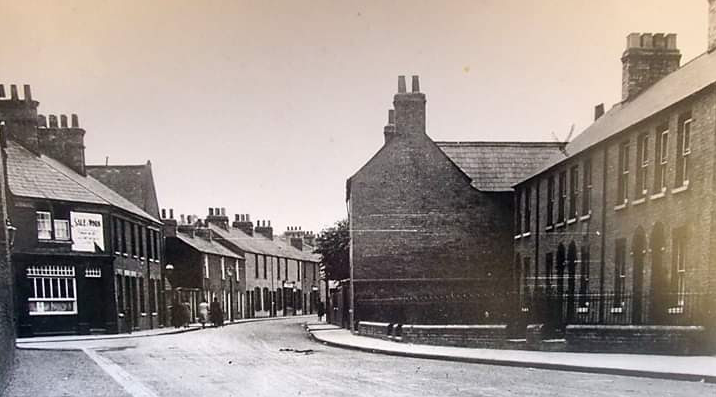 Junction of Ferry Lane and Chesterton High Street
Junction of Ferry Lane and Chesterton High StreetThe Hall Cottages, 205 – 213, High Street Chesterton
History of Hall Cottages
1911 (5)
David William Langley, 42, carman, b Chesterton
Alice, 37, b March
William David, 12, b Chesterton
Sidney Arthur, 10, b Chesterton
George Edward, 8, b Chesterton
Adelaide Alice, 5, b Chesterton
Annie Mary, 1, b Chesterton
1913 The Hall Cottages
(5) D W Langley, labourer
(4) Archie Daish, gardener
(3) Alfred Shipp, labourer
(2) Thomas Norfield, labourer
(1) Horace Brown, brewer’s carman
On 27.8.1914, Sidney Langley aged 13, a member of the 4th Cambridge Boys Brigade, at great personal risk gallantly attempted to rescue Driver W Hewson, of the Royal Field Artillery, who was drowned while bathing in the River Cam. Sidney was presented with the Boys Brigade Cross of Heroism and a Royal Humane Society’s honorary testimonial.
Cambridge Independent Press 28.8.1914
SOLDIER DROWNED. Boy’s Plucky Attempts at Rescue STOURBRIDGE CAMP TRAGEDY
A soldier named Hewson of the R.F.A., the driver of an ammunition wagon, was drowned yesterday (Thursday) afternoon in the Cam at Stourbridge Common. The tragedy took place during clothes’ washing parade. Hewson went into the river with his shirt and pants on and swam out into mid-stream. He had not been in the water long when he appeared to be in difficulties, but knowing that he was a swimmer, and thinking that he was larking, his comrades took no notice. Realising that the man was really in danger, a boy of 13, named Sidney Langley, of Old Chesterton, who was bathing in the river, swam to Hewson’s assistance, and held out his hand to him. Hewson grasped his hand, and both sank, and the boy was pulled under. They came to the surface. The boy was still holding Hewson, and they sank again. When they came to the top a second time the man let go of Langley’s hand, and the boy, being exhausted, was unable to do anything else but only just managed get to the bank himself. Hewson’s body was subsequently recovered by soldiers, and Capt. Rudkin, of the R.A.M.C. tried artificial respiration for some time, but without avail. The body was taken to the mortuary in Mr. John Brignell shell.
Cambridge Independent Press 9.10.1914
CHESTERTON BOY’S BRAVERY. Humane Society’s Award. STOURBRIDGE COMMON TRAGEDY RECALLED. The Mayor (Mr. J. A. Sturton) performed at the Cambridge Borough Court on Tuesday morning a ceremony which he described as the pleasantest duty that he had had to perform in the Court since he became Chief Magistrate. The ceremony was the presentation of the Royal Humane Society’s certificate to Sidney A. Langley, the 13-year-old schoolboy, of 5 Hall Cottages Old Chesterton, who nearly lost his life in attempting to rescue Driver Hewson of the R.F.A., who was drowned whilst bathing in the Cam off Stourbridge Common while the troops were encamped in Cambridge. The certificate, which is the honorary testimonial of the Society, is of vellum, beautifully illuminated. The heroism of Langley is recorded as follows:—‘for having on the 27th of August, at personal risk, gallantly attempted to rescue William Hewson, who was unfortunately drowned whilst bathing in the Cam at Cambridge.’’ The Chief Constable presented the lad, whose gallant conduct, he said, he brought before the Society. The Mayor said he had great pleasure in presenting the certificate. He need hardly say that was one of the pleasantest duties which he had fallen to his lot as Mayor during his year of office, and certainly the pleasantest duty he had had to perform in the police court. He was glad to present that parchment which testified to the lad’s gallant conduct. In doing so he recognised that he was only a boy of 13, and that when he dived into the river to try to save that soldier he was diving to the rescue of not a girl or a boy of his own age and weight, but to save a man who was very much heavier than himself. This was a brave deed for a boy of which his parents and friends would be extremely proud. “Your peril” he said to the lad, “must have been very great. You will always try I know, to do your duty in life manfully in the spirit of that wonderful self-sacrifice which prompted this deed.” The boy then received certificate, for which he thanked the Mayor.
These were included in the properties sold by Trinity Hall in 1924:
Lion Hotel, Friday 11th July at 6pm 1924 sale of 18 modern dwellings by Trinity Hall including:
– the Master Cottages, Scotland Road, 5 terraces houses
– the Hall Cottages, North side of High Street, 5 houses
– Garden Land situ between 1 and 2
– Latham Cottages (5 cottages) and 142, 144 and 146 High Street. Built in 1895 and let at weekly rents of 4s each to Messrs W Warren, E Amon and Mrs Maskill; total rent annual 3321 4s 0d. Lot inc passage 4ft in width leading to the gardens at the back.
Each containing living room front with boarded floor and tiled stove; kitchen back with boarded floor, portable range, cupboard in recess and store cupboard under stairs; scullery in addition at its back with tiled floor, open fireplace, copper and sink; coal house and WC adjoining in lean to; 3 bedrooms, gas and water supplies are laid on.
1965
(205) Anthony Davis
(207) Peter J Chaplin
(209) W S Baird
(211) Joseph Madej
(213) Clifford Langley
1970
Hall cottages demolished
Contribute
Do you have any information about the people or places in this article? If so, then please let us know using the Contact page or by emailing capturingcambridge@
License
This work is licensed under CC BY-NC-SA 4.0





